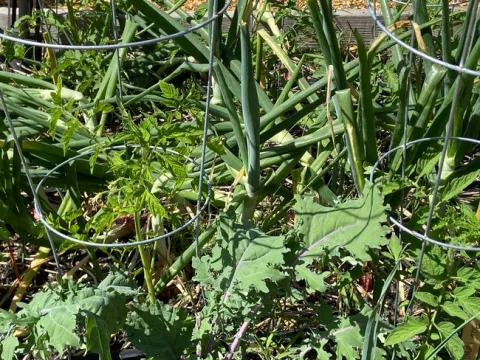Words have many definitions, but when I was studying anthropology of education, I learned that from an anthropologist's point of view, “agriculture” is different from “horticulture”. The difference is that “agriculture” is based on growing food or other products to sell. Crops are planned so that they ripen at the same time to allow for most efficient tending, picking, and sales. I believe that many home gardeners model their vegetable raising practices after agriculture. This can lead to problems, such as having thirty broccolis in one week, and none the next week.
“Horticulture”, when applied to growing vegetables and herbs, takes a different approach. I learned about this when working with Southeast Asian hill tribe people, the Iu Mien and Hmong, in school gardens in Sacramento. They practiced horticulture. Every week they harvested, then replanted. The garden became a complex, biodiverse place where there was something to eat every day, because crops were planted weekly. Some plants were always ready to eat, while others were still growing.
In our Central Valley, we can garden year-round, following two main seasons. The “winter garden” is planted in fall and harvested in late winter to early spring. The “summer garden” is planted in spring and harvested all summer and in the fall. But as my gardening techniques become more nuanced, learning from expert horticulturalists like the Iu Mien, I realize that I too can eat out of my garden almost every day of the year, if I constantly plant and harvest. In some cases, I can also redefine the parts of plants that are edible. For example, instead of eating the big broccoli, then pulling up the plant, I continue to eat the side broccolinis for months to come.
In late May, my five small planting beds have seventeen kinds of vegetables, not counting the many varieties of tomatoes and peppers. Some vegetables are being harvested, some are young, and a few are just being planted from seed. (I do not grow crops that take large spaces, such as corn and melons, but focus on the smaller vegetables which fit my beds.)
At the moment, my garden is in transition and I am eating the following vegetables: bulb onions, 3 kinds of lettuce, fall chard, fennel, fall carrots, kale, and potatoes.

Many variables which govern when it is time to add or take out a certain plant. But the basic principle of complex “horticulture” in raised beds might be useful to many people like myself who want something to eat daily, rather than a big crop at a certain time, followed by periods without crops.

